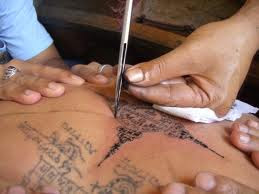Japanese Technique
Samoan Technique
Western Technique

Ancient Thai Technique
Techniques of Tattoo Body Art
Western Technique
In the western countries, an electric machine is used for the purpose of tattooing. The machine was invented in England and patented in the late 1800s. However, till date, it has undergone a few changes only, with the basics remaining the same. In the western technique, a solid needle, placed in a metal tube dipped into a cup of ink, is moved up and down a body part. A foot pedal is used to control the on and off positions of the machine. While only one needle is needed to make the outline of the intended design, coloring and shading requires groups of needles, arranged into even numbered flat configurations.
Japanese Technique
Japan has its individual style of tattoo making, which has been, to a certain extent, derived from the traditional methods. A hand-based style of tattooing, the Japanese technique makes use of elaborate bamboo handles. The handles incorporate a bunch of needles within themselves and work in a way much similar to a hand-powered tattoo machine. While making the tattoo, the artist stretches the skin with one hand and making use of his spread fingers, dips the brush into black ink.
Samoan Technique
Yet another tattoo technique that is related to the Pacific culture comprises of the Samoan one. In this tattoo technique, wooden hand tools are made use of. The tattoo artists works with the help of two basic tools, namely a bone-tipped rake and a striking stick. The rake is dipped in ink and placed against the skin. Thereafter, it is struck with the stick, resulting in the puncturing of the skin. As the artist moves the rake, a pattern is formed on the skin. In this method, a group of assistants help keep the skin taut, while the artist forms the designs.
Ancient Thai Technique
The tool that is used for making tattoo, as per the ancient Thai technique, is quite similar to the one used by the westerners. The tattooing tool comprises of a long brass tube, along with a sliding pointed rod that runs down the centre of the rube. The artist makes use one of his hands to steady the skin of the client, while the other is used to dip the tool in ink and pierce the skin with it, just like the needle of a sewing machine. The ancient Thai tattoos revolve around Buddhism and have religious symbols as the main designs.
